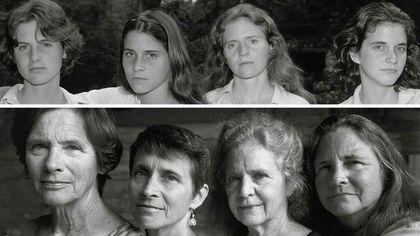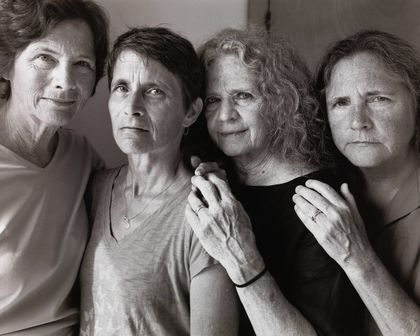The passage of time
When we are young we think that we are going to live forever. Death is something that we never talk about.
02 NOVEMBER 2017 · 08:32 CET

The years go by leaving their indelible marks on our face. The photographs that Nicholas Nixon has taken of the Brown sisters, every year since 1975 – now exhibited at the Fundación Mapfre in Madrid – show that age is merciless and ageing is a reminder of our mortality.
The photographs reveal physical manifestations of the passage of time. It can be seen in the expressions, gestures and the fashion dating each scene. The first photograph was taken in 1974, when Nixon was 26 and was already married with Beverly (BeBe), the eldest of the sister, but the photograph with which the series begins was taken the following year, when his wife was 25 years old.
BeBe always appears second to the right – they stand in the same order every year –. The youngest sister, Mimi, was then 15. She is the second to the left in the photos. At either side stand Heather and Laurie, who were respectively 23 and 21 when the first photo was taken in 1975.
They began to take them during family get-togethers in the summer, although they apparently already had a tradition of taking a photograph every Christmas.
The girls themselves choose each year’s photo, shot using a tripod and printed in black and white. This has been happening for over forty years. The couple met in 1970.
They got married the following year and they still continue with the same ritual of taking an annual photograph, wearing casual clothes and a relaxed expression although they never smile. Many have remarked upon the strength of their expression, seeming to suggest a determined and independent personalities.

SINGLE CHILDREN
The image of a group of sisters attracts the attention of the photographer, who is a single child and whose parents were both single children. That is also my own case and that of my father before me.
In the 1970s and 80s couples generally tended to have two or three children, and in the 50s and 60s they had even more. Now being an only child has stopped being an anomaly and is becoming pretty normal.
Single children are thought of as being spoilt and selfish, tending to prefer their own company to spending time with others. We are said to live in a world of fantasy and to struggle to relate to others.
I don’t know how much narcissism and isolation comes from being a single child, but it is true that we are captivated by relationships between siblings, as something that we have never known ourselves. We forget about the rivalry and conflicts, envying them the intimacy of those confidants that parents, however much attention they give, will never be.
Nixon’s fascination with fraternal relationships is always linked to the idea of mortality. What will happen when one of the sisters dies? He says that he will continue even though they are only three, two or one. The only thing is that he might be the first to die. At the beginning of the 1980s, the shadow of the photographer starts to appear in the picture, as if he would like to join in the group. The last photographs announce the inevitable end.

INEVITABLE END
“We are not here forever”, Nixon says. Death not only makes us face up to the futility of life, but also to its transient and brief nature. As we age we not only change but we also realise that life is short. When I think that my mother died when she was my age I get shivers down my spine. The day is coming.
When we are young, we think that we are going to live forever. Death is something that we never talk about; it is the great taboo of our society, just like sex was in the Victorian era. The bodies we see on ads are eternally youthful. No one wants to think of death.
The Bible’s vision of death is realistic. It is “the last enemy”, according to 1 Corinthians 15:26. It should not be trivialised. Behind a lot of super-spirituality lies a profound inhumanity, as if only the soul mattered. Even Jesus cried when faced with the tragedy of death (John 11:35).
However, the believer does not face death without hope (1 Thessalonians 4:13). Jesus came to free us from the fear of death, which keeps us in slavery throughout life (Hebrews 2:15). We have reason to hope for a better life (2 Corinthians 5: 1-10).
Published in: Evangelical Focus - Between the Lines - The passage of time
